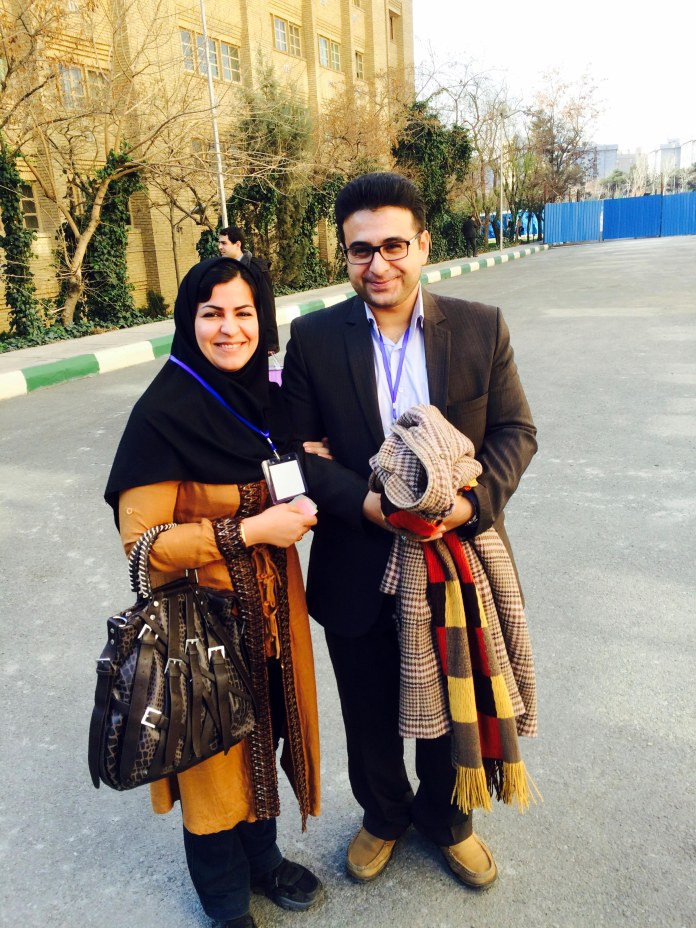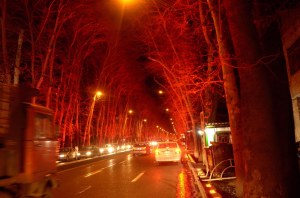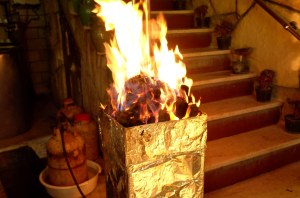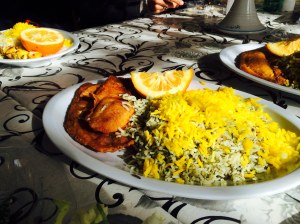In early November 2014 I received an email invitation to deliver the keynote address at the Third Annual Conference of the International Association for the Philosophy of Religion in January 2015 in Tehran, Iran. The Iranian Association for the Philosophy of Religion (IAPR) hosts the conference in cooperation with Tehran’s Tarbiat Modares University. I was informed that my former Dartmouth colleague Steven Katz had delivered this address at the 2014 conference. Checking with Steve, I was assured that the invitation was serious and that I would be warmly welcomed and respectfully treated in Tehran.
There were good reasons for turning down the invitation. I had a speaking obligation right after the conference’s closing date, Mary Jean for several reasons could not accompany me, and after a rash of scary movies like “Argo” and “Rosewater,” Iran raised fears. But I accepted the invitation. Checking schedules, I saw that could make it back just in time for my American commitment, and this could be a first exploratory visit, with Mary Jean accompanying me if I returned there in the future.
A major factor in my thinking was the signs of change taking place in U.S.-Iranian relations. With serious talks underway on ending economic sanctions in return for a halting of Iran’s nuclear program, and with ISIS becoming a common threat to both the nations (“The enemy of my enemy is my friend.”), I thought that this might be a good moment to serve, however modestly, as an ambassador of good will. I also thought it was less likely right now that I would find myself in an international incident.
The conference was scheduled for January 6 and 7. I was slated to depart late on Friday, January 2, arriving in Tehran early on Sunday, January 4. My U.S. speaking commitment required me to return by January 10, so this would be a short trip: four days on the ground in Tehran, departing Tehran on January 8. Steve Katz had had an extended stay that allowed him to visit Isfahan and Persepolis, but unfortunately my schedule wouldn’t permit that. The conference organizers said that they would plan several additional talks for me in the vicinity of Tehran before the start of the conference to fill out my stay.
Travel to Iran requires a visa. Because we have no diplomatic relations with Iran, I had to go through the Iranian “interest section” in the Pakistani embassy in Washington. Apparently Steve had some trouble with this, receiving his visa at the last moment after much delay and after needed interventions by the conference hosts, but Steve is a noted Holocaust scholar, a matter that could cause the Iranian authorities to give him a close look. Though I have written on Jewish ethics, it was unlikely that I was a person of interest. In the event, my application was accepted and my passport returned within 48 hours with an attractive visa inserted. A sign of Iranian good will?
JANUARY 2-4:
My itinerary had me traveling on Lufthansa via Frankfurt. The transatlantic leg went smoothly. In the transit lounge at Frankfurt, I noticed something odd. Of the more than one hundred women present, young and old, only one wore a headscarf. I thought that maybe these were all foreigners traveling to Iran, but when we landed in Tehran and had to go through passport control, most of the group went through the Iranian lines. So they were Iranian women outside Iran and almost none chose to wear a headscarf. Shortly before the plane landed, the purser made an announcement saying that head coverings are required of all women by law in Iran, and as we readied to exit the plane, the scarves appeared. What to make of this? Was I traveling with a largely secularized expatriate group? Or do Iranian women themselves, at least those affluent enough to travel abroad, dislike the clothing regulations? (Two days later in Tehran I put this question to an Iranian woman at the conference. She replied that what I saw was understandable because “Ninety percent of Iranian women don’t like the veiling requirement.”)
Speaking of passport control, my arrival in Tehran was momentarily nerve-wracking. While the whole group of foreigners was quickly ushered through passport control, I was held back, my passport was taken, and I was shunted through several offices. I quickly learned that this was in order to take my fingerprints (as the U.S. now also does for most foreign visitors). The delay took only about fifteen minutes, but my apprehensions throughout it reminded me of how many fears and stereotypes we have about Iran, generated by films like “Argo.” The reality (obligatory fingerprinting) may sometimes be more innocent.
Despite my delay, my welcoming party, Javad Teheri, Executive Director of the Iranian Association for Philosophy of Religion, and his wife, Mahshid Alvandi, were waiting at the exit from baggage claim, bearing a sign with my name on it. Here are Javad and Mahshid in the next day’s sunlight:
We climbed into a cab and in short order began a small seminar on rational religious theory. Javad aspires to add a Ph.D. in philosophy of religion to his M.A. He is an intense and enthusiastic young man. Mahshid was a conference assistant, and in the days ahead, with good cheer she helped keep things on track. The long day ended at the upscale Parsian Engheleb (“Persian Revolution”) Hotel. I checked in against a backdrop of Beetles Muzak. The only Iranian presence was this drawer in my room, where the Gideon Bible was replaced by a Quran and prayer rug.
SUNDAY, JANUARY 4:
The bright morning view from my hotel window revealed the towering (12,000 foot high) mountains that border the northern side of the city.
This was my first day on the ground and I was pretty much on my own. Having gone to bed around 4:00 AM Iran time, I slept until eight and rose to catch the hotel breakfast (mostly familiar breakfast foods but also some Iranian specialties, such as a yellow bean porridge). I then set out on the street in front of the hotel to change some money. Because of sanctions, our credit cards don’t work here. I had in mind the report of an academic colleague who attended a conference here last year and who, on missing his plane because of Tehran traffic had to spend an extra day in Tehran without money and without eating. In view of this, I thought it would be wise to have some cash in my wallet. This proved more challenging than I suspected. The hotel reception wouldn’t change money and directed me to a bank directly across the street, but that bank required a passport for exchange and the night before I had to surrender my passport to the hotel reception for the duration of my stay there (“Catch 22”). At the incomprehensible Farsi-accompanied pointing of a kindly woman bank employ, I set off doubtfully in the direction of a large building some distance away. This turned out to be a massive galleria shopping center, with many banks . . .
. . . several of which turned me down until I was directed to a specialized “Exchange” operation. There, a friendly older man and a young woman for whom I was the only customer in evidence exchanged $40 for me at a rate of about 30,000 rials to the dollar (yes that’s thousands, and climbing fast daily as a result of the sanctions). Wandering through the galleria, I noticed that there were few shops open and the space seemed desolate and forlorn. This confirmed what Javad and Mahshid told me in the cab the night before, that U.S.-led sanctions have had a profound effect on the Iranian economy.
I continued walking further along the hotel avenue trying to get close to a huge mural on the side of a building. It seems to honor hero martyrs (of the Iran-Iraq war?)
On returning to the hotel, I noticed another large mural on the wall of an adjacent building.
What you see here are two empty army boots, and a seemingly mystical dis-apparition of the soldier whose boots they were. This was another memorial to a martyr of Iran’s eight-year long (1980-88) war with Iraq.
In the early afternoon, two of my hosts, Professor Mohsen Javadi of Qom University and his colleague Mohammad Saeedimehr of Tarbiat Modares University stopped by and we went over the week’s plans. One of my preconference talks was to have been at Qom, and I was eager to see the beautiful holy city, but to my disappointment this did not work out. In place of that visit, Prof. Javadi had scheduled two talks for me before leading medical ethics organizations in Tehran.
About 8:30 that evening, Prof. Saeedimehr returned to pick me up for a tour of the city. The evening was chosen because Tehran’s daytime traffic is awful (so bad that alternate day restrictions are imposed on car entry into the center city) but things ease up by nightfall. We headed westward to Freedom (Azadi) Square, a monument built under the Shah but now reframed as a tribute to Iraq’s liberation under the Islamic Revolution.
Here is a selfie of Mohammad and me in front of it:
This drive to Azadi Square was a bit of an emotional turning point for me. Like almost all Americans who can remember the events of the Islamic Revolution, including the takeover of the U.S. embassy and the seizure of its staff as hostages, I have a largely negative view of those days and of the regime that followed. As we drove the long thirteen-kilometer avenue from the hotel to the monument, Professor Saeedimehr told me that he had been among the tens of thousands of young people who marched down that avenue amidst the excitement of Ayatollah Khomeini’s return and the overthrow of the hated Shah. He said that he and the others were filled with hope for Iran’s new beginning and the vision of a more just society. In the 1980s, he expressed his enthusiasm by volunteering for military service in the Iraq-Iran war, eventually losing many friends in the conflict. Saddam Hussein, he said, started the war predicting that the Arabic-speaking ethnic groups in the southwest of Iran would rise up on his side and that the conflict would only last three days. Neither prediction proved correct. The Arab-speaking Iranians remained loyal to their country, and the war dragged on for eight years, with at least 300,000 dead on the Iranian side. The U.S. backed Saddam in that war. “For Saddam and America,” my host said bitterly. “it was all about oil.” Suddenly, I was jolted into a very different view of all those events. Here was a colleague, the kind of intelligent and liberal professor I might find anywhere in the U.S. or Europe, defending the Islamic revolution in the name of social justice, and offering a picture of his country as the innocent victim of ill-considered U.S. interventions.
After the square, we headed north to the Darband district. On the way, we transited a Vali Asr Street, which is bordered by trees that are illuminated by lines of roadside lights changing colors every few seconds:
Darband Square. . .
. . . forms the base of one of several narrow river valleys in the mountains that rise to the north of the city. A stone walkway climbs up the valley along the river (really just a small rivulet), and food stalls and restaurants line the route. You can ascend for kilometers, tempted by street food and glittering restaurants. The stalls and restaurants stay open until the early hours of the morning, and on hot summer nights (it was now cool, at about fifty degrees Fahrenheit) thousands of people come out each evening for a walk and dinner. Mohammad and I ascended for about two kilometers. Here are some views of our walk.
One of the food stalls offering sweets and candied fruits:
This is a dish of steamed fava beans. We bought a bowl, slid a bean out of its covering with our fingers and popped it into our mouths.
And here’s a display of everyone’s favorite snack food, cooked beets:
Brightly lit restaurants line the walk up:
Here is a clever little business. Pay its owner, and one of the little birds picks a card that tells you your fortune:
A selection of skewers and raw meats prepared for roasting;
With a roaring fire ready to do the cooking nearby:
On the way back to the hotel, we passed two beautiful, brightly lit mosques. These are in true Persian style and much more ornate than the simpler ones I’m used to in Morocco:
Back at the hotel, I was lulled to sleep by the call to prayer. Because Shi’a Muslims (and Iran is overwhelmingly Shi’a) condense two of the five daily prayers into its adjacent one, the call occurs only three times a day, and it is much quieter and more musical than those I’ve heard in Sunni countries.
MONDAY, JANUARY 5:
Tuesday began when I was picked up at 9:30 am by Dr. Ehsan Shamsi Gooshki, director of the Medical Ethics Department of the Medical Council of the Islamic Republic of Iran. He would take me to the Medical Ethic and History of Research Center, another site of medical ethics studies in the city. This was located at some distance, and I confess a hair-raising drive across the city from my hotel. I’ve mentioned Tehran’s traffic. At full bore in the daytime it is a mixture of thousands of cars, pedestrians and motorcycles in an intricate choreography in which racing vehicles and darting people miss one another by centimeters. Lane markers might as well not exist or, better, sometimes serve only as guides which drivers use to point their vehicles. Long ago, I resolved never to drive in India. I’ve added Tehran to the list.
The Medical Ethics Center is located in one of Tehran’s larger hospitals. I walked with Dr. Shamsi down the busy corridors and was ushered into the endocrinology and metabolism research unit and the office of that unit and the Center’s director, Dr. Bagher Larijani. Over beverages, he offered a PowerPoint presentation of the Center’s many activities, ranging from its active Ph.D. program in bioethics to its development of ethics materials for the nation’s health care system, including a widely distributed “Patient’s Bill of Rights” that I am told is displayed in hospitals everywhere. I learned from Dr. Shamsi, that Dr. Larijani is one of five brothers who play significant roles in Iranian society. One is the chairman of the Parliament of Iran, another heads Iran’s judicial system, and the two others also have important governmental positions. Smiling, Dr. Shamsi added, “They’re the Kennedy’s of Iran.”
At 10:30 we went to a well-appointed seminar room for my presentation “Is ‘Dignity’ a Useful Concept in Bioethics?” About thirty people were present, including about 20 Ph.D. students, all of whom were also M.D.s. More than half the members of the audience were women. My presentation, with some of my organizational points and longer quotations projected in a PowerPoint, went very well. I spoke slowly, and the students seemed to understand what I was saying. Although their spoken English was not as strong as their comprehension, they were filled with questions based on their individual thesis projects. With a break for lunch, the Q&A continued, and the questions that followed were amazing. All were in areas of great interest to me: access to assisted reproductive technologies (ARTs), abortion, human enhancement, physician-assisted suicide, the physician’s duty when confronted with abusive or negligent parents, and the commercialization of kidney transplantation. Iran is unique among almost all nations in having a government-regulated and partly government-financed system that permits transplant recipients to pay donors for a kidney. The system appears to be imperfect (under-the-table payments apparently persist despite government regulation), but on the positive side it has eliminated the long waiting lists for kidneys that predominate in the U.S. and elsewhere. I hope to learn much more about this in the future.
One thing I’m seeing and learning about in the course of this visit is the Shi’a community’s commitment to rationality at all levels, as distinct from the Sunni prioritizing of revelation. Centuries ago, this issue was joined in the conflict between the Ash’ari (revelation) and Mutazilite (rationalist) parties, and the Ash’ari position won out in most of the Sunni world. Not so among the Shi’a, whose opposition to the Sunni caliphate (for whom Ash’ari authoritarianism was convenient) led them to favor the Mutazilite position. This commitment to reason explains my presence here at the invitation of an almost unique Islamic program in the Philosophy of Religion. Scholars (and physicians) here are also proud of the perspective in which reason works hand in hand with revelation, and sacred teachings can be accommodated to changing realities. One small biomedical illustration of this that I learned about during the course of the Q&A is Iran’s permission for egg and sperm donation in ARTs. This is forbidden in the Sunni lands because of traditionalist concerns with strict lineage preservation. Shi’a jurists, in contrast, seem willing to go beyond traditional constraints when medical realities and rational policy recommend doing so.
Still jet-lagged, and after an intense day of speaking to and learning from my Iranian bioethics colleagues, I had dinner at the hotel, and went to bed early.
TUESDAY, JANUARY 6:
The conference began today. Up at 5:00 am after only 5 hours sleep and still way off my sleep cycle, it was going to be a challenge to give my keynote address in the morning and follow a busy roster of others’ talks throughout the day. Taxis waited for the transfer to Tarbiat Modares University. The hair-raising drive across Tehran did more to wake me up than the breakfast coffee. The conference began in a large assembly hall with what seemed to be equivalent to a pledge of allegiance ritual to projected images of Imam Khomeini, the revolution’s founding father, a brief taped recitation of a passage from the Noble Quran and short welcoming speeches from university officials. Here are several pictures of the conference poster, the large hall, and me, as requested, delivering my greetings as the conference keynoter and sole American participant:
We then broke up into two sections, one English speaking, the other Farsi. In addition to a substantial complement of Iranian speakers and attendees, conference participants were quite international, with speakers coming from England, Italy, Germany, Northern Ireland, Tunisia, Kuwait and Mexico.
My keynote, “Kant’s Philosophy of Religion and the Challenges of Moral Commitment,” went very well, and the Q&A was lively. Here are some snapshots of the morning’s activity. Note the large number of women scholars present.
(That’s me)
At the coffee break, I was able to chat briefly with one of the women scholars attending (I learned her name is Zohreh), who raised a particularly good question during discussion. She’s here in the middle:
Just before lunch, we were given a walking tour of Tarbiat Modares University. The university was established after the revolution and is dedicated to graduate programs only, most in medicine and STEM fields but with a solid humanities division in which the philosophy of religion program is based. Here’s the library outside and in:
And here’s a helpful librarian:
A beautiful mosaic-covered campus mosque
And in front of it, a monument to three unknown martyrs of the Iran-Iraq war.
The plaques below specify their ages (all were in their twenties based on information gleaned perhaps from medical analysis), but their identities are unknown.
The day ended back at the hotel with a boisterous dinner for speakers and hosts that began after eight and went on for several hours.
A word here about Iranian food—in Iran. Persian restaurants in the states are among my favorites. (There is a terrific one in Naples, Florida, named “Bha! Bha!,” a Farsi expression used for good food or good odors meaning “Wow! Wow!”) All of the meals I had in Iran had the same format: a substantial array of starters in the form of fresh salad preparations, olives, pickles, salty feta-like cheeses and so on, followed by a main course featuring a pile of saffroned rice over or beside a grilled lamb kebab, or grilled chicken or fish. The whole dish would be enlivened with a grilled whole and sliced fresh tomato and lemon or orange wedges.
Drinks included sodas or a bottled yoghurt drink that was popular but that I found too sour. The food was always very good, but the same.
I saw no sign of the many tagine-like dishes featured at “Bha! Bha!” In fairness, this was all university, medical center, or hotel food. On the way back to the airport on Wednesday night, Javad and Mahshid shared some of the take-away dinner they brought from a good local restaurant, a delicious layered confection of cornbread and spiced ground meat.
WEDNESDAY, JANUARY 7, my final day in Iran.
This morning’s conference meeting had several very good papers. One, however, by a Polish Catholic scholar, Janusz Balicki, raised sharp questions.
The title of Balicki’s paper was “Immigrants from Muslim Countries in a Secular Europe: A Challenge or an Opportunity for Christianity?” It began by describing the “decline” in “family values” in Europe which he believed to be signaled by marital cohabitation, declining birth rates, and legally-recognized gay marriage. Balicki saw this as an opportunity for family-valuing and “pro-life” European Christians to build a new social and political coalition with equally traditionalist Muslim immigrants. During the Q&A, Lutz Alexander Keferstein of Mexico pointed out that it is often the most conservative Christians throughout Europe who are among the most vehement opponents of Muslim immigration.
After attending the conference this morning and lunch, I was driven by Dr. Shamsi, to the Headquarters of the Iranian Medical Council (the equivalent of our A.M.A.) and ushered into the office of Dr. Alireza Zali, a neurologist and President of the Council. Our chat was followed by an hour and a half session on medical professionalism with 20 of the staff in their Council’s Medical Ethics Department, which Dr. Shamsi heads. Of my three talks, this was the least prepared and most controversial, dealing near its end with physician-assisted suicide and euthanasia, but once again, the Q&A was stimulating. At one point, in response to my mention of physicians’ professional obligation to report instances of child abuse, the question was raised about whether there can be exceptions to this. In the intensely patriarchal environment of some rural Iranian families, my questioner observed, reporting abuse can sometimes endanger the child.
At the close, Dr. Shamsi (who arranged the Monday talk but was not present for it) mentioned the possibility of an invitation to me to return this summer for a one or two week course on biomedical ethics for their Ph.D. students. I will have to look at my schedule. This may be a chance to visit with Mary Jean and see more of the country. I’m also very interested in learning more about their regulated kidney-exchange program.
My visit ended at 10:30 that evening, when I was picked up again by Javad and Mahshid and transported to the airport for my 2:50 AM flight to Frankfurt. The lead-time was needed because the airport lines at each point (ticketing, security and boarding) were daunting and I got to my seat only minutes before the scheduled departure time. As the Lufthansa plane lifted off, I felt some of the relief depicted at the same moment in the film “Argo.” In my case, it was not so much relief from fear, but from a travel environment shaped by sanctions (no credit cards or phone service), strict documentary requirements, and unfamiliar mores. For example, early on I was advised never to shake a woman’s hand, and at the conference I had to repeatedly still my impulse to do so.
Some final impressions. I believe Iran is far different from the Iran of our media-shaped American imaginations. For one thing, it is a highly developed if temporarily economically handicapped nation. Tehran can rank besides any European city, and its “feel” and people are far closer to a European sensibility than anything I’ve experienced in Sunni Islamic nations (Morocco, Tunisia, Egypt). There is also a sharpness and precision to people’s discourse and behaviors that makes one feel one is in a slightly down-at-the heels France rather than in a more southern Arab country. Is this a reflection of Shi’a rationalism (some of my hosts thought so), the cooler weather, or Persia’s great imperial legacy and culture?
Second, there is genuine pride about the Islamic revolution, and a strong feeling, even among some young people who identify with the recent progressive “green” protest movement, that the West in general, and America in particular, don’t understand Iran. During breaks in the conference or during transport, I had the chance to speak with several students and young people about political issues, and while some expressed unhappiness with the regime, there was a tendency to think that the indigenous problems have been worsened by Western interventions. The traditionalism of the Islamic revolution makes it easy to miss the fact that, like Cuba, this is a country whose revolution commands substantial support and pride from its people.
There is a dark side. While religious traditionalists—and they include some of the able university and medical professionals I met—view the revolution and government in very positive terms, more secularized individuals don’t like imposed and omnipresent religiosity and control. Women vary in terms of dress, with the more religious wearing the dark full body and head cover, and more secular women wearing only a scarf or headpiece. Several of the more secularized women that I spoke to told me that they deeply dislike gender-based restrictions that have been imposed. One said that she dreams of leaving Iran and feeling the wind blow through her hair. On the positive side, these restrictions have apparently facilitated a massive movement of women from more traditional sectors into education and other public functions. Women now make up sixty percent of medical graduates.
Some of my interlocutors also quietly expressed to me their discomfort with what they saw as a generally repressive intellectual environment. One said, “If you speak openly about what you believe, you can land in prison.”
Of course, I was only four days in Iran, and that is hardly enough to found or authenticate any of these views. But there is a conclusion about which I feel confident. For Western travelers, Iran is not the terror state depicted by Hollywood. Tehran is a safe city—much safer than Paris I was told, a remark too soon confirmed—and the people themselves are overwhelmingly friendly to Americans. On my first day’s walkabout, I was asked several times where I came from, and when I said “America,” I received warm smiles and greetings. Once you get your visa, you can travel to Iran, travel freely within the country, see its marvelous historic sites, speak easily with people many of whom manage in English, and you can leave whenever you are ready to do so. (Just bring cash and get to the airport early on your return!) Perhaps if more Americans visited, and, above all, if political leaders on both sides move toward more accommodation, we can renew our appreciation of this amazing people and culture.





































Thank you Ron, I miss you both very much too! I look forward to seeing some of the Films especially ‘The Nibelungen since I read the Book in German in my Youth! I hope ypu are all doing well. For me it has indeed been a very challenging Summer by losing my dear Brother very suddenly and going back and forth between Belfast Maine and Florida.
Thinking of you and the Family
With Love Margot